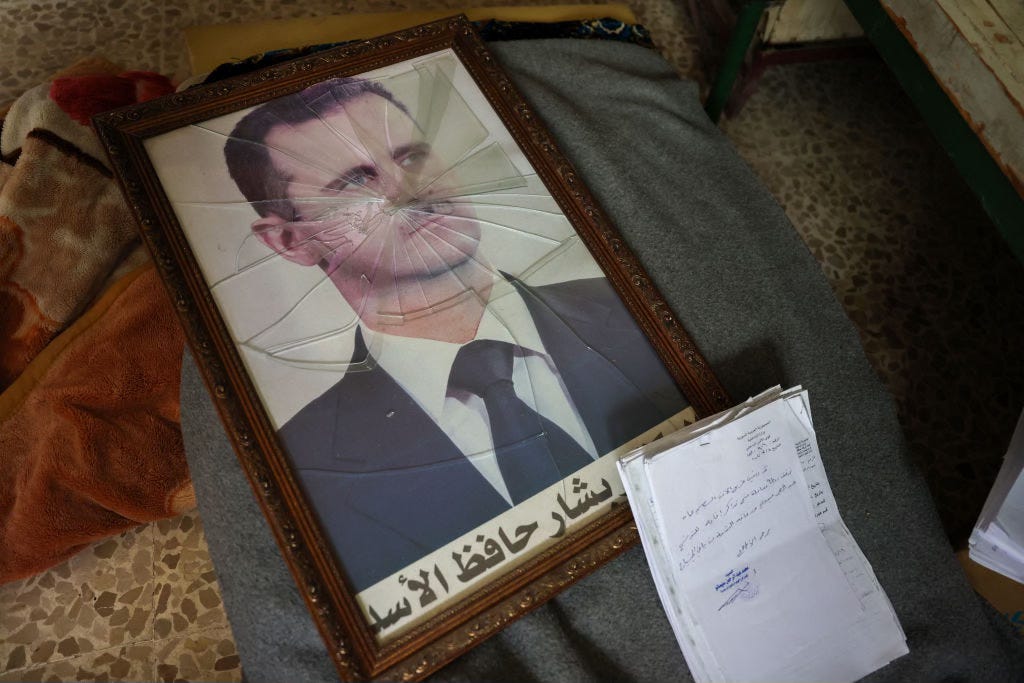Assad Flees, U.S. Stays
Secret U.S. forces remain in Syria. Here’s who and where
If you thought the fall of Syrian dictator Bashar al-Assad might mean the U.S. military is done operating in the country, think again. Within hours of Assad fleeing the country, President Biden announced that “we will help ensure stability in eastern Syria, protecting our personnel against any threats.”
Biden wasn’t kidding: yesterday, the U.S. carried out a spree of strikes on supposed ISIS positions, including dozens of airstrikes on over 75 targets. The closest thing we got to an explanation for the volley came from Gen. Erik Kurilla, U.S. military commander for the Middle East, who made clear that whatever changes were taking place in Damascus, the U.S. military’s role would be more of the same. “There should be no doubt … we will not allow ISIS to reconstitute and take advantage of the current situation in Syria,” Kurilla said in a press release.
What there seems to be plenty of doubt about is what U.S. personnel are even in Syria and where. The U.S. government hates talking about its military footprint throughout the Middle East. When three U.S. troops were killed in Jordan earlier this year, many Americans were surprised that there was even a base near the Syrian border. The U.S. government had never before officially acknowledged the base, nor the mission. Secrecy over American military deployments is out of control and prevents the American public from meaningfully participating in discussion of our foreign policy.
Let’s pull back the curtain shrouding the truth about our military presence in Syria.
The Pentagon acknowledges about 900 troops based in Syria, but the actual number is nearly double that, according to well-placed military sources and documents we’ve reviewed. This number includes clandestine forces of the Joint Special Operations Command (JSOC) that operate under numbered task forces and are quite independent of the conventional military units in Syria. On the clandestine side, JSOC is joined by CIA paramilitary and covert operations in country, Defense Intelligence Agency operations focused on human intelligence collection, Defense Threat Reduction Agency WMD-related operations focused on Assad’s chemical arsenal, and other intelligence and counterintelligence operations on the ground that spy on the Russians and Iranians.
Because these forces are clandestine, the White House can say they only have much smaller conventional forces operating in the country on stuff like the relatively uncontroversial counter-ISIS mission Kurilla mentioned.
The clandestine forces operate from at least ten bases and outposts, according to documents we’ve reviewed. CENTCOM, the command responsible for the Middle East, publicly acknowledges six bases:
At Tanf Garrison (FOB ATG),
Mission Support Site Conoco,
Mission Support Site Euphrates,
Mission Support Site Green Village,
Patrol Base al-Shaddadi, and
Rumalyn Landing Zone (FOB RLZ).
Four additional bases — Abu Hajar, Malikiyah, Robariye, and Tall Baydar — have been mentioned in documents as currently hosting U.S. personnel. There are additional bases just outside Syria (such as Tower 22 in Jordan, where the attack killing three U.S. troops occurred) that directly support U.S. military forces located in Syria.
Operations in Syria against ISIS generally fall under Operation Inherent Resolve, the 25-nation coalition that has ground forces in Syria, Iraq, Jordan, and Kuwait. Fighter and bomber aircraft supporting the Syria mission are based in the same four countries, plus Saudi Arabia, the UAE, and Qatar.
There are additional U.S.-only organizations and operations that focus on specific and restricted operations, as well as counter-Russia, counter-Iran and counter-terrorism tasks outside the ISIS mandate:
Combined Joint Interagency Task Force Syria in Qatar, focused on vetting operations for yet another group of opposition Syrian soldiers on the U.S. payroll;
Special Operations Joint Task Force Operation Inherent Resolve (SOJTF-OIR) in Kuwait, that oversees the special operations;
Joint Special Operations Task Force Levant, headquartered in Kuwait, that has shadowy missions separate from Operation Inherent Resolve;
The SOCOM-led Gallant Phoenix operation, focused on tracking and assessing foreign fighters in Syria, with headquartered in Jordan;
Operation Spartan Shield, an operation headquartered in Kuwait that is focused on Iran and Iran-backed militias and hosts the largest U.S. ground contingent; and
Cobalt Spear, a counter-WMD operation focused on Syria’s chemical (and possibly biological) weapons.
Other clandestine and intelligence operations have been mentioned relating to Syria, including Nomad Shadow in Turkey, Project 3HN, Talon Anvil, and Iron Echo, according to documents we’ve reviewed.
Army, Navy, Air Force, Marine Corps, and National Guard troops have been stationed in Syria during 2024. The Army special forces come predominantly from the 7th Special Forces Group at Eglin air force base in Florida, though other special operations forces, including Navy SEALs and Air Force special tactics have also been employed.
National Guard from at least Georgia, Maryland, New Jersey, Oregon, and Virginia have deployed to Syria over the past year, including infantry and artillery units. And then there are the contractors who operate drones and aircraft, conduct maintenance, feed and house the troops, and keep everything running.
No wonder Biden stresses “protecting our personnel.” The bombing operation yesterday feels like a parting gift as the U.S. anticipates being shown the door by the new government in Damascus. But undoubtedly Washington will negotiate a forever presence. Unless there’s a public pushback, which isn’t possible if the public doesn’t even know we’re in Syria.
— Edited by William M. Arkin


“Inherent Resolve”, Gallant Phoenix”, Spartan Shield”, erc. Does the DoD have a full time office that’s dedicated to coming up with these movie title sounding names? No matter what they call it the US has no business there without Congressional authorization.
So much lying from our own government even from a fairly truthful administration. Infuriating!